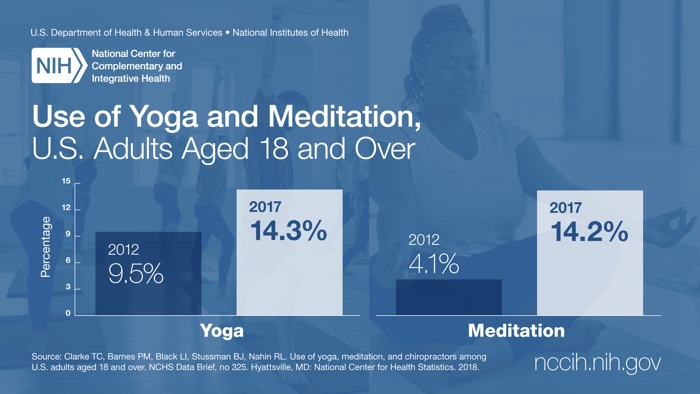The number of Americans practising yoga and meditation is booming, with new research showing a sharp increase in the amount of people embracing complementary health.
According to new figures, both yoga and meditation have surged in popularity since 2012, with the latter being practised by more than three times as many adults in 2017 – but the surprising thing is the gains are actually dwarfed by even greater uptake among children and teens.
The findings of a new nationally representative survey conducted by the National Institutes of Health (NIH) and the Centres for Disease Control and Prevention (CDC) reveal that yoga was practised by an estimated 35.2 million American adults aged 18 and older in 2017 (14.3 percent of the population, up from 9.5 percent in 2012).
That's almost exactly a 50 percent increase in just five years' time – making it the most commonly used complementary health approach by adults; and it only just beat out meditation, which saw even more rapid gains since 2012.
Back then, 4.1 percent of American adults reported meditating at least once in the last 12 months, but the new data indicate this group swelled more than threefold by 2017, rising to 14.2 percent of the population (again representing about 35 million people).
 (NIH)
(NIH)
As impressive as these increases are, the boost in the number of children using yoga and meditation are even more remarkable.
Among children 4-17 years of age, 8.4 percent of respondents had practised yoga at least once in the past year in 2017 (more than double the 3.1 percent recorded in 2012).
And again, the boost in meditation was even more pronounced than yoga, with 5.4 percent of children reporting they'd mediated in 2017 – an amazing ninefold gain on the 0.6 percent of child-age respondents in 2012.
For the purposes of the questionnaire, yoga was defined to mean the combination of breathing exercises, meditation, and physical postures that are used to achieve a state of relaxation and balance of mind, body, and spirit.
The survey recognised numerous forms of meditation involving "mental exercise to reach a heightened level of spiritual awareness or mindfulness", including mantra meditation, mindfulness meditation, and spiritual meditation (and their associated forms).
The research – with data collected from the National Health Interview Survey (NHIS), which is run by the the CDC's National Centre for Health Statistics (NCHS) – didn't include questions on why adults and children were more open to yoga and meditation, so we can't be 100 percent sure why these practices are so much more popular than they were in 2012.
That said, the researchers speculate that greater availability of yoga and meditation classes and studios (including sessions at schools) – plus TV programs and smartphone/online apps – are all helping to boost awareness of complementary health services.
It's also possible that the stresses of contemporary life have something to do with it.
In the face of worrying troubles like climate change, pollution, gun violence, and a highly charged atmosphere in American politics and culture – all endlessly relayed by a 24/7 news environment on phones and other screens – the ideals of relaxation and mindfulness may seem more appealing than ever before.
"Many forces in our culture have conspired to elevate anxiety and stress — in part due to a lot of messages related to fear in the media — and this makes people unsettled," neuroscientist Richard Davidson from the University of Wisconsin Madison, who wasn't involved with the research, told Vox.
"I think there is an increasing interest in strategies like yoga and meditation that can help people adjust to modern circumstances."
And unlike alternative medicines that aren't supported by valid science – which can be very dangerous to take in place of actual, scientifically tested drugs – yoga and meditation are examples of complementary health therapies that can offer a number of generally recognised benefits.
In other words, if you approach them with the right expectations, they're harmless and might actually help boost your health – something that's reassuring in an era when deadly addictions to conventional medications like opioids are so common they're even lowering American life expectancy.
Still, if you're interested in taking practices like yoga and meditation up, take the time to educate yourself about what you can expect to get out of them, because there's a lot of hype about 'mindfulness' these days when it comes to health, and the benefits don't always add up.
The findings are reported on the website of the National Centre for Health Statistics here and here.
